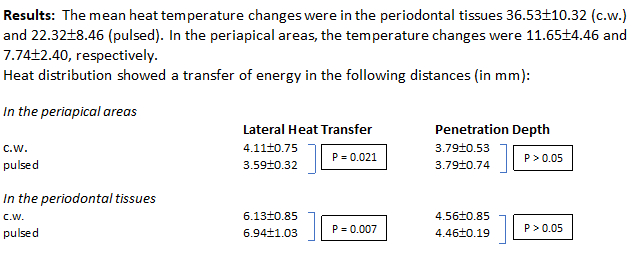IADR Abstract Archives
Thermographic Effects of 445nm-Laser in Periodontal and Periapical Areas
Objectives: Visible light diode lasers have been introduced recently in the dental market due to their high soft tissue cutting efficiency and excellent hemostatic effects. The aim of this study was to demonstrate the heat (energy) transfer within the periodontal and periapical areas using the blue light (445nm) diode laser.
Methods: Mandibular bovine anterior teeth were endodontically prepared after instrumentation up to #70/.04 ProFileÒ-rotary file. Posterior teeth were used for laser-assisted periodontal therapy. A diode laser (445nm), with a continuous (c.w.) and a pulsed mode (15 Hz, 50% duty cycle) was utilized to irradiate the root canal (glass fiber: 120m) for 30 seconds (n=20). Periodontal pockets were irradiated for 30 seconds (glass fiber: 320m). The utilized power was 2W in continuous mode and pulsed mode with non-initiated tips.
The maximum temperature changes (in oC) and heat transfer in height (penetration depth) and width (lateral heat transfer) were captured using a thermographic infrared camera placed perpendicular to the beam direction. The heat distribution in the periapical and periodontal areas during the entire irradiation period was measured and calculated (in mm). Descriptive statistics were performed presenting mean values and standard deviations. Comparative statistics were calculated using the paired t-test for c.w. and pulsed modes at the 5% statistical significance level.
Results: The mean heat temperature changes were in the periodontal tissues 36.53±10.32 (c.w.) and 22.32±8.46 (pulsed). In the periapical areas, the temperature changes were 11.65±4.46 and 7.74±2.40, respectively.
Heat distribution showed a transfer of energy in the following distances (in mm):
In the periapical areas, the lateral heat transfer of continuous wave and pulsed setting are 4.11±0.75 and 3.59±0.32, respectively (p= 0.021). The penetration depth is 3.79±0.53 and 3.79±0.74, respectively (p > 0.05)
In the periodontal tissues, the lateral heat transfer of continuous wave and pulsed setting are 6.13±0.85 and 6.94±1.03, respectively (p = 0.007). The penetration depth is 4.56±0.85 and 4.46±0.19, respectively (p> 0.05).
Conclusions: Within the limitations of this study, a 445nm-diode laser might cause lateral heat distribution compared to a penetration depth in periodontal and endodontic applications.
Methods: Mandibular bovine anterior teeth were endodontically prepared after instrumentation up to #70/.04 ProFileÒ-rotary file. Posterior teeth were used for laser-assisted periodontal therapy. A diode laser (445nm), with a continuous (c.w.) and a pulsed mode (15 Hz, 50% duty cycle) was utilized to irradiate the root canal (glass fiber: 120m) for 30 seconds (n=20). Periodontal pockets were irradiated for 30 seconds (glass fiber: 320m). The utilized power was 2W in continuous mode and pulsed mode with non-initiated tips.
The maximum temperature changes (in oC) and heat transfer in height (penetration depth) and width (lateral heat transfer) were captured using a thermographic infrared camera placed perpendicular to the beam direction. The heat distribution in the periapical and periodontal areas during the entire irradiation period was measured and calculated (in mm). Descriptive statistics were performed presenting mean values and standard deviations. Comparative statistics were calculated using the paired t-test for c.w. and pulsed modes at the 5% statistical significance level.
Results: The mean heat temperature changes were in the periodontal tissues 36.53±10.32 (c.w.) and 22.32±8.46 (pulsed). In the periapical areas, the temperature changes were 11.65±4.46 and 7.74±2.40, respectively.
Heat distribution showed a transfer of energy in the following distances (in mm):
In the periapical areas, the lateral heat transfer of continuous wave and pulsed setting are 4.11±0.75 and 3.59±0.32, respectively (p= 0.021). The penetration depth is 3.79±0.53 and 3.79±0.74, respectively (p > 0.05)
In the periodontal tissues, the lateral heat transfer of continuous wave and pulsed setting are 6.13±0.85 and 6.94±1.03, respectively (p = 0.007). The penetration depth is 4.56±0.85 and 4.46±0.19, respectively (p> 0.05).
Conclusions: Within the limitations of this study, a 445nm-diode laser might cause lateral heat distribution compared to a penetration depth in periodontal and endodontic applications.

